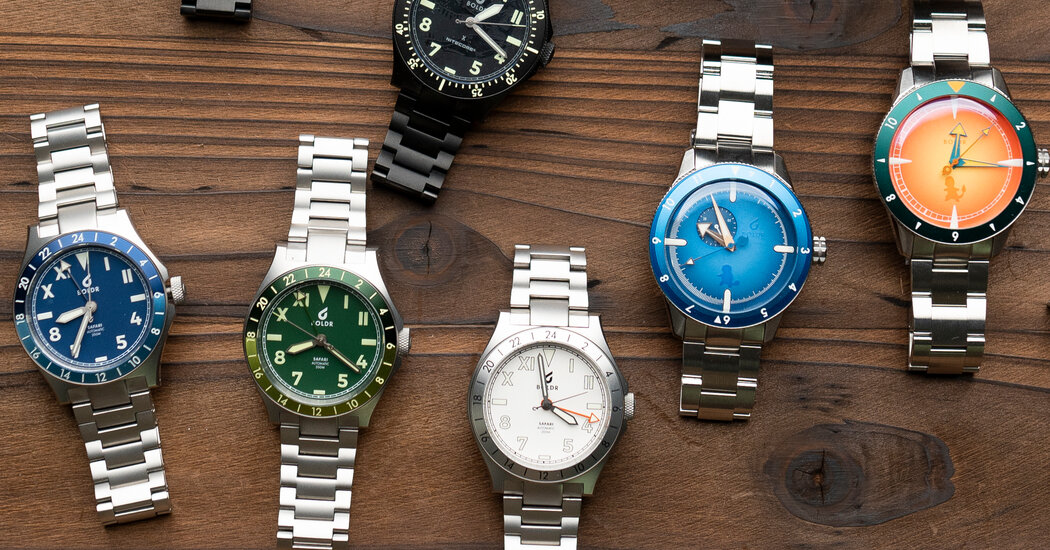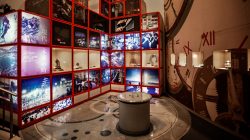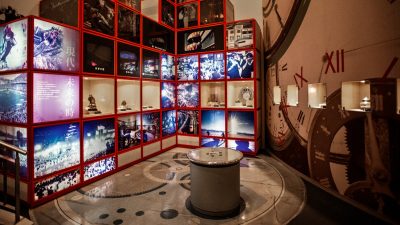Singapore is flourishing as a market for Swiss watches, and its homegrown watch brands are blossoming, too.
Fifty years ago, according to its profile on the World Bank site, the country suffered from severe unemployment and poor infrastructure, but decades of internal investment have helped develop a high-income economy. And many of its approximately 5.5 million residents are buying high-end watches.
Between January and May, exports of Swiss watches to Singapore rose to 676.4 million Swiss francs, an 8.6 percent increase over the same period last year, according to the Federation of the Swiss Watch Industry. The results prolonged its ranking as the world’s sixth largest market, ahead of Germany, France and the United Arab Emirates.
In January, LVMH Watch Week, an annual showcase of brands from the French luxury giant, came to Singapore for its fourth iteration. And a second edition of Spring Sprang Sprung, the microbrand fair that debuted last year, is scheduled for Oct. 20-22.
All the activity means “more people are more aware about watches and watch collecting,” said David Sze, 34, the founder of Humism, a local watch brand.
Both major brands and local makers agree that Singaporeans favor big names. Rolex represented 42 percent of all 2021 sales in the city, while Omega claimed 12 percent, and Patek Philippe, 7 percent, according to Fflur Roberts, Euromonitor’s head of luxury goods research.
Concentrated in the high-density shopping areas along Orchard Road and in the Marina Bay Sands resort complex are many single-brand boutiques and multibrand shops like Sincere Fine Watches and The Hour Glass.
Panerai, a brand owned by Richemont that is based in Florence, Italy, has boutiques in both areas. Jean-Marc Pontroué, Panerai’s chief executive, said the shop in the ION Orchard shopping mall is particularly busy. “We have about 40 people entering every day, sitting and trying watches,” he said, which he noted is about twice the number of daily shoppers in other Panerai boutiques around the world. “For a mono watch brand, it’s a very good number.”
No one could provide a firm number on how many watch stores are in Singapore, but they are spreading beyond the center to areas like the Resorts World Sentosa, an island off Singapore’s south coast, which includes an outlet of the Swiss Watch Gallery, a multibrand retail chain, and other shopping malls in residential areas.
Some of Singapore’s interest in major brands has been generated through local watch clubs, like the Singapore Watch Club, which has had special-edition watches designed by companies such as Cartier, Hublot and Ulysse Nardin. The club has more than 50,000 followers on Instagram, and it regularly schedules events across the city.
RedBar Group, which describes itself as the world’s largest watch enthusiast and collector community, also has a chapter in Singapore with more than 150 members and more than 1,200 Instagram followers.
One RedBar member, Ivan Chua, 46, founded the watch company Vario in 2016. He joined the club “to network with other watch enthusiasts,” he said from his home office in the city center, where he has designed six collections, including a limited-edition 40-millimeter Swiss-quartz reversible dual-time watch (priced at $421).
“We have events at the watch brand’s boutique,” he said, “or there are some meet-ups where everybody brings a few of their watches and we sit at a long table and we will be talking about watches and looking at each others’ watches.”
“It’s good for me,” he added, “as I see firsthand what the local market likes,” recalling one session last fall where participants shared a Tissot PRX, a new Cartier Tank, a 24-karat gold Grand Seiko and some timepieces by Mitch Mason, a microbrand based in Singapore.
Local watchmakers agree that overseas buyers, mainly from the United States and Europe, are their main targets. Leon Leong, 38, owner of the watch and accessories maker Boldr Supply Company, said overseas buyers make up 80 percent of his clientele.
But many Singaporeans who support local brands are “people who are just starting out, you know, learning about watch collecting,” said Sugiharto Kusumadi, 46, founder of the multibrand retail chain Red Army Watches.
Mr. Kusumadi also co-founded the Spring Sprang Sprung watch fair, which featured 13 local watch brands among the 24 exhibitors and attracted more than 1,300 visitors, he said in a text message. He hopes to nearly double the number of local exhibitors this year, he added.
Some entrepreneurs who created local watch brands say they faced steep learning curves.
Benjamin Chee, 37, said he had no business experience in 2012 when he started his first brand, Maison Celadon, selling Chinese-made watches and “learning the ropes as I went along, making a lot of mistakes and losing a lot of money,” he said.
He now owns four watch brands, including Benjamin Chee Haute Horlogerie, which has collaborated with makers including Andersen Genève on timepieces like a platinum 37.7-millimeter automatic world timer with a map of Singapore on the dial.
The watch, which sells for 58,800 Swiss francs, or $65,740, was designed to appeal to buyers in Singapore who are watch lovers and connoisseurs, according to Pierre-Alexandre Aeschlimann, president and chief executive of Andersen Genève.
There is risk-taking among the local watch brands, too. Cody Chua, 31, who founded the brand Coup De Coeur in 2015, opted for a barrel-shape case for the unisex 44-millimeter stainless-steel model Élan because “a circular shape is too common,” he said.
Most local watch entrepreneurs sketch their ideas or use computers, with the plans then going to manufacturers in countries like China. The completed timepieces are often stored and distributed from home offices.
Working from Singapore can make it hard to secure the highest quality product because “you don’t have the personal network,” said Ray Pee, 45, who had no watch industry experience when he founded Gane Watches in 2020. “So I was searching in countries like Japan and Germany,” he said, before finding a manufacturer in Switzerland.
But his engineering background helped, he said: “I had a lot of experience in sourcing, discussions on specifications, in engineering drawings and in machine capabilities. It helps with my discussion on what design is viable and what is not,” and when negotiating prices.
There are some efforts underway to improve watchmaking skills in Singapore.
Gijs Terhorst, an instructor at the Patek Philippe Institute, which offers a two-year program in Singapore, said by email that it had trained 11 watchmakers since 2017, five of whom were Singaporean.
Red Army Watches said it runs 24 classes a year in its store at the Suntec City shopping mall “for people to, you know, try out,” Mr. Kusumadi said, and “have a taste of watchmaking before they take a more serious course. Because it’s not cheap to go to Switzerland, and you end up spending like $50,000 for the whole course.”
The one-day program, called The Watch Academy, can be booked on the retailer’s website for $412.52 per person. Mr. Kusumadi said new collectors often want to tinker with their watches, but “they do not know how to open up the case, how to remove the hands.” The course offers basic instruction on dismantling and reassembling watches and the tools to use.
Mr. Chee said he has been developing an apprentice program for his haute horology brands since 2021, and now he has five students between 18 and 35 years old who were born or live in Singapore and who are now learning enamel work and other techniques from watchmakers in Switzerland, China and elsewhere.
He is also building a new home studio in La Zagaleta, Spain, near Marbella. Mr. Chua of Vario said his five-year plan includes “going more into craft.” Mr. Pee said he wants to experiment with a dive watch or a chronograph. In a later email, he wrote that he now has initial designs for a 38-millimeter chronograph that he intends to unveil next year.
Sumber: www.nytimes.com










